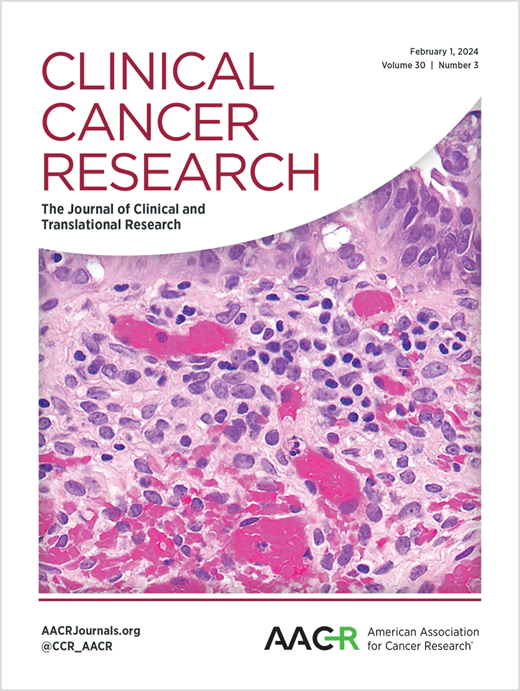Integrated metabolomics and spatial transcriptomics of cystic pancreatic cancer precursors reveals dysregulated polyamine metabolism as a biomarker of progression
IF 10
1区 医学
Q1 ONCOLOGY
引用次数: 0
Abstract
Purpose: We conducted metabolomics and spatial cell transcriptomics of intraductal papillary mucinous neoplasms (IPMN), recognized pancreatic cancer precursors, to identify oncometabolites that inform upon risk of malignancy of IPMN. Experimental Design: Untargeted metabolomic analyses were performed on cystic fluid from 125 patients with low-grade dysplasia (LG) or high-grade (HG) dysplasia with/without concurrent PDAC (IPMN/PDAC). Predictive performance of individual metabolites for identifying HG or PDAC/IPMN was determined and compared to CA19-9 performance. Data were intersected with metabolic profiles of resected IPMN tissues and murine Kras;Gnas IPMN cell lines as well as spatial and single-cell transcriptomics of IPMN. Results: A total of 388 metabolites were quantified in cystic fluid of which 69 were differential (p-value <0.05) between cases (HG IPMN + IPMN/PDAC) and patients with LG IPMN. Spermidine and spermine biosynthesis and catabolism was identified as the top perturbed metabolic pathway (FDR-adjusted p-value< 0.0001). Increases in cystic fluid spermidine, n-acetylputrescine, acetylspermidine, diacetylspermidine, diacetylspermine, and acetylcadaverine were associated elevated risk of harboring HG or IPMN/PDAC. An OR-rule comprising CA19-9, n-acetylputrescine, acetylspermidine, and diacetylspermine achieved 54.8% sensitivity for detecting HG and IPMN\PDAC. CA19-9 alone yielded sensitivity of 11.9% (McNemar Test p-value< 0.001). Polyamines were elevated in IPMN\PDAC tissues compared to LG IPMN tissues; spatial and single-cell transcriptomic data revealed transcript levels of polyamine-metabolizing enzymes to be elevated in neoplastic epithelium and tumor-associated macrophages. Conclusion: Cystic fluid polyamines offer utility for determining risk of malignancy of IPMN that is complementary to CA19-9, and that has potential to aid in clinical management of patients with IPMN.囊性胰腺癌前体的综合代谢组学和空间转录组学揭示了多胺代谢失调作为进展的生物标志物
目的:我们对导管内乳头状粘液瘤(IPMN)进行了代谢组学和空间细胞转录组学研究,以确定IPMN恶性风险的肿瘤代谢物。实验设计:对125例伴有/不伴有PDAC (IPMN/PDAC)的低级别发育不良(LG)或高级别发育不良(HG)患者的囊液进行非靶向代谢组学分析。测定单个代谢物鉴别HG或PDAC/IPMN的预测性能,并与CA19-9性能进行比较。数据与切除的IPMN组织和小鼠Kras、Gnas IPMN细胞系的代谢谱以及IPMN的空间和单细胞转录组学相交叉。结果:囊液中共检测到388种代谢物,其中HG型IPMN + IPMN/PDAC组与LG型IPMN组有69种差异(p值&;lt;0.05)。亚精胺和精胺的生物合成和分解代谢被确定为最高扰动代谢途径(fdr调整p值)。0.0001)。囊液亚精胺、n-乙酰腐胺、乙酰亚精胺、二乙酰亚精胺、二乙酰精胺和乙酰尸胺的升高与HG或IPMN/PDAC的风险升高相关。由CA19-9、n-乙酰腐胺、乙酰亚精胺和二乙酰精胺组成的or规则检测HG和IPMN\PDAC的灵敏度为54.8%。单独CA19-9的敏感性为11.9% (McNemar Test p-value<;0.001)。与LG IPMN组织相比,IPMN\PDAC组织中多胺含量升高;空间和单细胞转录组学数据显示,肿瘤上皮和肿瘤相关巨噬细胞中多胺代谢酶的转录水平升高。结论:囊液多胺可作为CA19-9的补充,用于确定IPMN恶性肿瘤的风险,并有可能有助于IPMN患者的临床管理。
本文章由计算机程序翻译,如有差异,请以英文原文为准。
求助全文
约1分钟内获得全文
求助全文
来源期刊

Clinical Cancer Research
医学-肿瘤学
CiteScore
20.10
自引率
1.70%
发文量
1207
审稿时长
2.1 months
期刊介绍:
Clinical Cancer Research is a journal focusing on groundbreaking research in cancer, specifically in the areas where the laboratory and the clinic intersect. Our primary interest lies in clinical trials that investigate novel treatments, accompanied by research on pharmacology, molecular alterations, and biomarkers that can predict response or resistance to these treatments. Furthermore, we prioritize laboratory and animal studies that explore new drugs and targeted agents with the potential to advance to clinical trials. We also encourage research on targetable mechanisms of cancer development, progression, and metastasis.
 求助内容:
求助内容: 应助结果提醒方式:
应助结果提醒方式:


